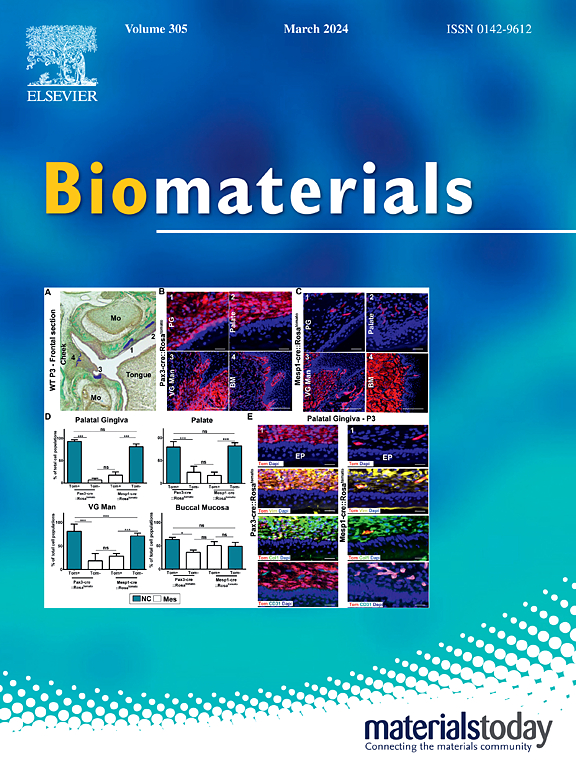Advanced nano delivery system for stem cell therapy for Alzheimer's disease
IF 12.8
1区 医学
Q1 ENGINEERING, BIOMEDICAL
引用次数: 0
Abstract
Alzheimer's Disease (AD) represents one of the most significant neurodegenerative challenges of our time, with its increasing prevalence and the lack of curative treatments underscoring an urgent need for innovative therapeutic strategies. Stem cells (SCs) therapy emerges as a promising frontier, offering potential mechanisms for neuroregeneration, neuroprotection, and disease modification in AD. This article provides a comprehensive overview of the current landscape and future directions of stem cell therapy in AD treatment, addressing key aspects such as stem cell migration, differentiation, paracrine effects, and mitochondrial translocation. Despite the promising therapeutic mechanisms of SCs, translating these findings into clinical applications faces substantial hurdles, including production scalability, quality control, ethical concerns, immunogenicity, and regulatory challenges. Furthermore, we delve into emerging trends in stem cell modification and application, highlighting the roles of genetic engineering, biomaterials, and advanced delivery systems. Potential solutions to overcome translational barriers are discussed, emphasizing the importance of interdisciplinary collaboration, regulatory harmonization, and adaptive clinical trial designs. The article concludes with reflections on the future of stem cell therapy in AD, balancing optimism with a pragmatic recognition of the challenges ahead. As we navigate these complexities, the ultimate goal remains to translate stem cell research into safe, effective, and accessible treatments for AD, heralding a new era in the fight against this devastating disease.
干细胞治疗阿尔茨海默病的先进纳米输送系统。
阿尔茨海默病(AD)是当代最重要的神经退行性病变挑战之一,其发病率越来越高,但却缺乏治疗方法,这凸显了对创新治疗策略的迫切需求。干细胞(SCs)疗法是一个前景广阔的前沿领域,为AD的神经再生、神经保护和疾病改变提供了潜在机制。本文全面概述了干细胞疗法在AD治疗中的现状和未来方向,探讨了干细胞迁移、分化、旁分泌效应和线粒体转位等关键方面。尽管干细胞的治疗机制前景广阔,但将这些研究成果转化为临床应用面临着巨大的障碍,包括生产的可扩展性、质量控制、伦理问题、免疫原性和监管挑战。此外,我们还深入探讨了干细胞改造和应用的新趋势,强调了基因工程、生物材料和先进输送系统的作用。文章讨论了克服转化障碍的潜在解决方案,强调了跨学科合作、监管协调和适应性临床试验设计的重要性。文章最后对AD干细胞疗法的未来进行了反思,在乐观与对未来挑战的务实认识之间取得了平衡。当我们驾驭这些复杂性时,最终目标仍然是将干细胞研究转化为安全、有效和可获得的AD治疗方法,预示着抗击这一毁灭性疾病的新时代即将到来。
本文章由计算机程序翻译,如有差异,请以英文原文为准。
求助全文
约1分钟内获得全文
求助全文
来源期刊

Biomaterials
工程技术-材料科学:生物材料
CiteScore
26.00
自引率
2.90%
发文量
565
审稿时长
46 days
期刊介绍:
Biomaterials is an international journal covering the science and clinical application of biomaterials. A biomaterial is now defined as a substance that has been engineered to take a form which, alone or as part of a complex system, is used to direct, by control of interactions with components of living systems, the course of any therapeutic or diagnostic procedure. It is the aim of the journal to provide a peer-reviewed forum for the publication of original papers and authoritative review and opinion papers dealing with the most important issues facing the use of biomaterials in clinical practice. The scope of the journal covers the wide range of physical, biological and chemical sciences that underpin the design of biomaterials and the clinical disciplines in which they are used. These sciences include polymer synthesis and characterization, drug and gene vector design, the biology of the host response, immunology and toxicology and self assembly at the nanoscale. Clinical applications include the therapies of medical technology and regenerative medicine in all clinical disciplines, and diagnostic systems that reply on innovative contrast and sensing agents. The journal is relevant to areas such as cancer diagnosis and therapy, implantable devices, drug delivery systems, gene vectors, bionanotechnology and tissue engineering.
 求助内容:
求助内容: 应助结果提醒方式:
应助结果提醒方式:


